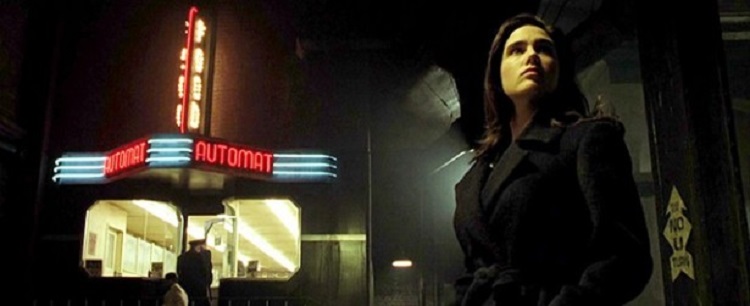Someone Else’s Nightmare | 20 Years In Dark City
If I have a favourite type of film, it’s the ones that have the taste of dreams about them. Where emotions drape across your mind like cobwebs and where the rules of logic are not suspended but rather seem to float out of reach, somehow unfamiliar. One of the quintessential movies of that type is Dark City, a film about memories and what makes us human. And creepy men in leather trench-coats, of course.
To explain too much about the plot of Dark City would be to spoil it, and it’s a film that doesn’t deserve spoiling. (Though if you have the theatrical release rather than the director’s cut the film itself will take care of that for you, via an overly explicit studio-mandated voiceover that gives away plot details not meant to be revealed until halfway through the movie.) Suffice to say a man (played by Rufus Sewell) wakes up in a bathtub with no memory of anything, even his own name. He’s in a hotel room with a ringing phone and a murdered woman. As he flees he’s pursued by strange men with chalk-white skin wearing black trenchcoats and black slouch hats. The city he flees into is as unfamiliar to us as it is to him, a strange mix of different eras of the 20th century. People’s memories don’t quite add up – a woman married for years is unused to her wedding ring, a man can’t remember being given a treasured memento. And though everyone’s been to the vacation spot Shell Beach, advertisements for which seem to haunt the protagonist, nobody can quite remember how to get there.

Dark City has been compared to The Matrix, which came out the following year. Both feature a hero who finds out that the world he’s been taking for granted has been faked by inhuman creatures who seek to extract something from them, though the villains of Dark City seek something far more ephemeral than body heat. It’s no coincidence that when we first meet Kiefer Sutherland’s character, a psychiatrist named Dr Daniel P Schraber, he’s running a rat through a maze. Schraber’s name is a nod to the intentions of these experiments, especially that being performed on the protagonist. Daniel Paul Schraber was a German judge who suffered from paranoid psychosis, and who wrote a memoir detailing his own mental disintegration, but insisted that he was still himself. [1] If Murdoch (as the protagonist turns out to be called) had the memories of a killer, then would he be a killer? And if memories do make us who we are, then what does a man without memories become?
Director and co-writer Alex Proyas was no stranger to wrestling with metaphysical quandaries in his films. His previous hit film had been 1994’s The Crow, a film about a man who returns from the dead to take revenge for the murder of his girlfriend and him. Though such a film could easily be nothing but action schlock, it’s instead a meditation on grief, revenge and the ability to move on. Cut with plenty of stylish action, of course. The other writers on the film are Lem Dobbs and David S Goyer. Goyer is definitely the most famous of the trio, as he would go on to write the Blade trilogy, the Christopher Nolan Batman trilogy, and the later DCEU films Man of Steel and Batman vs Superman. A mixed legacy, but one with a common thread of darkness and superheroics. Dobbs brought something else to the film. Among his other works he wrote Kafka for Steven Soderbergh in 1991. The film is part biopic, part adaptation of Kafka’s writings. And it’s a very Kafka-esque sensibility that infuses Dark City.

William Hurt and Jennifer Connelly round out the cast of heroes, but it’s Richard O’Brien as “Mr. Hand” who gives the most memorable performance. The mannerisms and appearance of the “Strangers” had been based on his performance in Rocky Horror Picture Show, and so Proyas was delighted when he was able to cast O’Brien as the most visible of their number. Other “Strangers” include Mr. Wall, played by Bruce Spence (the Gyro Captain from Mad Max 2) and their leader Mr. Book who is played by Ian Richardson (Francis Urquhart in the original House of Cards). But the real star of Dark City is the city itself. Production designer Patrick Tatopoulos blends together disturbingly anachronistic elements with the veneer of German Expressionist futurism over them (think Metropolis). The ever present theme of spirals and mazes, and the shifting architecture and impossible buildings), give the city a dynamism that means nowhere ever really feels safe.
Dark City was groundbreaking for its time. People didn’t expect science fiction to be smart and defy genre expectations, to hide itself in a cloak of noir convention. As a result, though it was a critical success, it under-performed at the box office. This wasn’t entirely its fault; the film came out while Titanic was two months into the ten months it stayed in theatres, and Cameron’s ship tended to run over everything in its path. Apart from Goyer few of those involved in the production went on to huge success, but the film remains deeply influential. One of the most notable and obvious movies to take inspiration from it was Inception, with its manipulation of reality and themes of dreaming and memory. It’s not surprising that Dark City had an influence though. Just like in the film, it seems like a place that’s impossible to ever really leave.
Images via nerdist and projected perspective.
[1] It’s usually a fool’s errand to to try to diagnose historical figures, but viewed through modern eyes Schraber’s illness seems likely to stem from a combination of gender dysphoria and the brutal experiments in childraising that his father (a psychologist) inflicted on his sons.

